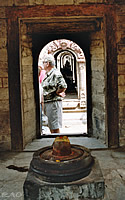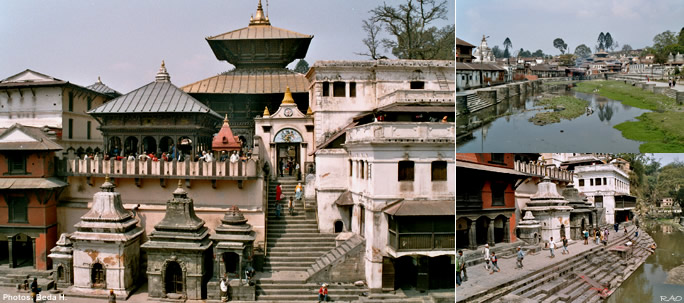|
The
Temples of Pashupatinath
|
Since
thousands of years, the 264-hecate-big complex of Lord Pashupatinath templeby the bank of holy river Bagmati, which shelters around 500 Hindu temples,
and also residences of the a thousand or so local people related, have
been the centre of creed. Beside being the prime centre of devotion for
the Hindus of the Himalayan Kingdom, it has been one of the most adored
pilgrimage for the Hindus of India too.
The
Pashupatinath Temple area is an abode of rituals and festivals around the
calendar. Mahashivaratri is the most widely celebrated festival in the
Pashupatinath area. Balachaturdashi, Haritalika Teej, Haribodhini Ekadashi,
Harishayani Ekadashi and Mukhastami are some of the local festivals.
The
temple is one among the seven major monument zones that makes the Kathmandu
Valley a UNESCO World Heritage Site. Apart from the main shrine, the temples
of Basuki, Unmatta Bhairav, Kotilingeshwar and some other are inside the
temple courtyard. Guheshowri, Vishowrup, Gorakhanath, Ram, Kirateshwar,
Rajrajeshowri, Batsaleshowri, Panchadeval, Bankali and Shitala lie around
the holy shrine.
And the temples of Battais Putali, Jaya Bageshowri, Charumati
Bihar, Chabahil Lokeshowr, Chabahil Stupa, Chandra Vinayak, Bhandareshowr
Mahadev, Tamreshowr Mahadev are some among other major shrines of the protected
monument zone.
 |
| Pashupati's lingam
The
historical cronicles atest that the form of the lingam, as the idol, have
came into existance in as early as by the beginning of the 5th century.
However, the present one should not be older than that of 1350 AD as that
was the year when a Muslim invader shattered the holy idol into pieces.
All
Hindus who have been there to scatter sadbeau light oil lamps in the name
of the dead soul on the eve of Balachaturdashi. Though there is no reliable
information when this tradition began, people believe that Lord Shiva first
commenced the tradition.
|
|
According
to Pandit Hari Nath Gautam, in the sacred book of Shivapuran, the Sadbeau
is the mixture of seeds like lentil, wheat, barley, maze, fruits and sweet
potato, among others. The tradition began after the death of Aghori (hermit
who eats everything) Balasur. When this baba of Aghorpanthi community turned
a man-eater, the other communities had a major tussle.
Then the people
from other communities convinced a barber, Balasur's childhood friend,
to kill him. After the homicide, a conflict broke out between the Aghorpanthi
community and other communities, resulting in mass murder. After the violence
and murder, both groups realised their mistakes and went to Lord Shiva
to forgive them. Lord Shiva then ordered them to scatter sadbeau in the
name of Balasur, in every place where Balasur used to wander around.
| Links |
 |
 |
 |
External
link |
|



